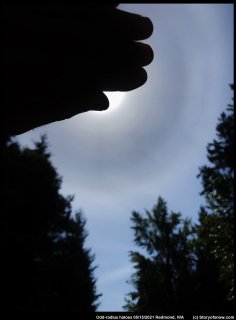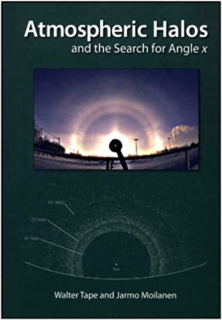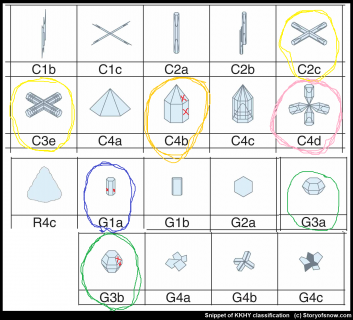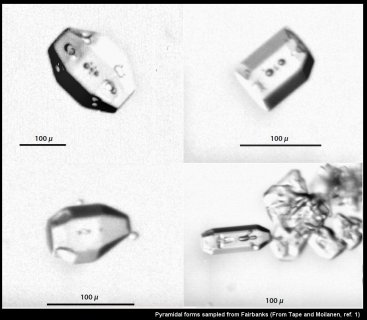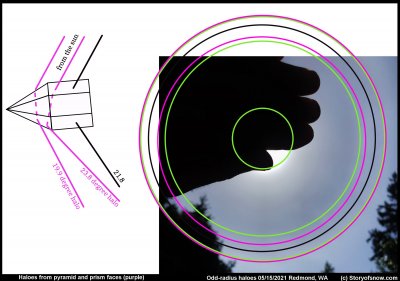| « Bright Tangent Arc After Sundown | Capturing Falling Snow in a Cold Fluid » |
Odd Radius Haloes and Pyramidal Crystal Faces
Out walking one day last spring, I sensed a subdued illumination--like a thin veil of cloud had drifted in front of the sun. I looked up, and indeed found that there was. Blocking out the sun with my hand, I surveyed the thin veil and saw a strange sight: instead of the usual 22-degree halo around the sun, I saw what looked like two closely spaced haloes near the usual 22-degree spot. I took a picture:
Below, I mark the positions of the observed haloes in green and in black the position that the common 22-degree halo should be. So, it appears that neither halo is that of the common 22-degree one from the prismatic crystals of ice. Now, I had heard of these rare haloes that can arise from non-prismatic crystals of ice, though always figured they were either illusionary or ultra rare.
In fact, there is a book written about these so-called "odd radius" halos and the determination of the ice-crystal faces that give rise to them (ref. 1):
The angle "x" in the title is the angle between two crystal faces, one face being a "pyramidal" face of ice, the other being a prism face. (The prism faces are the six faces going around the symmetry axis of a crystal, typically portrayed as forming a hexagon though for real ice crystals, the prism faces are often not all equal in size, thus making the perimeter not a symmetric hexagon.) Several kinds of pyramidal faces can form on ice, but ultimately, the angle x was determined to be that for the most common one, which has an angle of 28 degrees. If you look at the snippet of the KKHY classification below, these faces are those such as the ones marked with an "X" on types C4b and G3b circled below:
The lower "x" on these types mark a prism face.
However, in looking at various collections of ice particles sampled from clouds, I cannot recall seeing a clear image of G3b or G3a. They do exist though. Tape and Moilanen's "angle X" book shows G3b examples from Fairbanks, Alaska:
but they also emphasize that these crystal shapes appear to be quite rare elsewhere. One reason might simply be that they may be regularly sampled, but not discerned as such due to their small size: most crystal sampling in clouds do not have enough resolution to discern the shapes of crystals less than 50 micro-meters across, and it only requires crystals larger than about 10 micro-meters to produce good haloes.
Out of curiosity, I wondered if maybe the haloes I saw might be due instead to crystal forms that are much more commonly observed, the C2c and C3e types that are circled in yellow in the KKHY figure above. An interesting paper in 1987 by Weinheimer and Knight (ref. 2) showed how the rare "Scheiner's halo display is likely due to those "double-crystals" when they are very small. Now double- or multi-crystals ("polycrystals") can have any relation between their central axes. However, an interesting finding from 1972 is that the angle between any two columnar axes is strongly peaked at 70 degrees, giving specific angular relations between the crystal faces. Other than the 27.8 degree "Scheiner's" halo, they show how several other new haloes are possible. Here are two that I compare with my observation:
As that shows, the agreement between predicted (yellow) and observed (green) is poor, particularly for the smaller 16.5-degree prediction.
For the pyramidal crystals, I get the following better agreement:
So, it appears that despite the apparent rarity of the crystals with pyramidal faces, they appear to have been present in sufficient number to produce haloes near 20 and 24 degrees.
We have no way now of knowing what exactly the crystals looked like, but laboratory experiments seem to find the C4b crystals (circled in orange in the KKHY table above) more readily producable than the G3b or G3a.
For example, in ref. 4 Magono et al. (1979) find C4b to form from large frozen droplets below -25 C:
Their argument was that they had formed the pyramidal faces on one end only because the droplets had produced a "spicule", or spike, upon freezing, sort of like the spikes you might see on an ice cube.
So, that seems to be the end of my quest to find the source of the odd-radius haloes I saw on that walk of May 15, 2021.
To better understand what is happening in similar situations, we really need to have a) better resolution sampling of small crystals in clouds and b) more laboratory experiments of freezing droplets in atmospherically relevant conditions. In addition, I have never heard of a detailed halo simulation of polycrystals such as C2c, C3e, and C4d with a distribution of angles such as those found by Lee (1972). For example, in the above simple calculation of the yellow circles, I assumed crystals of C2c, all with exactly a 70-degree relation instead of the slight spread that Lee found:
Even if you are not in the business of working on the above issues, you can still keep an eye out for those "odd-radius" haloes. You might even discover a new one.
--JN
References and notes
1) Walter Tape and Jarmo Moilanen, Atmospheric Halos and the Search for Angle x. American Geophysical Union, Washington, DC, 2006.
At least for the present time, a free pdf version is at https://scholarworks.alaska.edu/handle/11122/6400
2) Weinheimer, A. J. and Knight, C. A.: Scheiner's Halo: Cubic Ice of Polycrystalline Hexagonal Ice? J. Atmos. Sci., 44, 3304-3308, 1987.
3) Lee, C. W.: On the crystallographic orientation of spatial branches in natural polycrystalline snow crystals. J. Meteor. Soc. Japan, 51, 171-180, 1972.
4) Magono, C., Fujita, S., and Taniguchi, T.: Unusual Types of Single Ice Crystals Originating from Frozen Cloud Droplets. J. Atmos. Sci., 36, 2495-2501, 1979.
